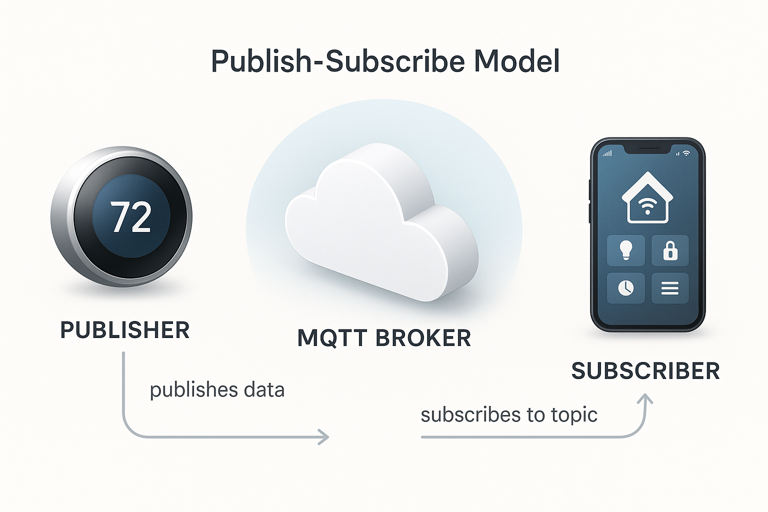This post may contain affiliate links. If you click through and make a purchase, we may earn a commission at no additional cost to you. This helps support our work and allows us to continue providing valuable content. For more information, please see our disclosure policy.

Ever wondered how your smart thermostat knows when you’re coming home, or how your fitness tracker seamlessly syncs data to your phone? Behind the scenes, that smooth communication is often powered by a lightweight protocol called MQTT (Message Queuing Telemetry Transport).
Think of MQTT as the postal service of the Internet of Things (IoT). But instead of delivering letters, it delivers tiny packets of information between your smart devices and the cloud, using as little data and battery power as possible.
What Makes MQTT Special?
MQTT stands out in the crowded field of communication protocols because it was designed specifically for devices that need to:
- Conserve battery power (like your smartwatch or wireless sensors).
- Work with limited Internet bandwidth (think rural areas or mobile networks).
- Handle unreliable connections (when your W-iFi drops out momentarily).
- Scale to thousands of devices (smart city infrastructure).
The protocol achieves this through three key design principles, which are:
- Lightweight messaging: MQTT messages have minimal overhead, making them perfect for devices with limited processing power.
- Publish-Subscribe model: Instead of devices talking directly to each other, they communicate through a central message broker, which can be thought of like a switchboard operator routing calls.
- Quality of Service (QoS) options: You can choose how reliably messages need to be delivered based on importance.
A Brief History: From Oil Fields to Smart Homes
MQTT has an interesting origin story. Back in 1999, IBM engineers needed a way for remote oil pipeline sensors to send data back to control centers. These sensors were often in remote locations with poor connectivity and limited power, so they built a protocol that was light, efficient and reliable under tough conditions.
The solution they created was so effective that it quickly spread beyond the oil and gas industry.
- Early 2000s: Adoption in retail, logistics and agriculture.
- 2010: Officially standardized by OASIS.
- 2019: MQTT Version 5 released, adding better error handling and load balancing.
Today, MQTT powers everything from your smart doorbell to massive industrial systems with thousands of sensors.
MQTT Keeps Getting Better: Version 5 Updates
MQTT isn’t a “set it and forget it” technology. In 2019, the latest major update (Version 5) introduced several improvements that make connected devices work even better.
- Better Problem Solving: When something goes wrong with your smart devices, the system now provides clearer information about what happened, making it easier for developers to fix issues quickly.
- Flexible Messaging: Devices can now attach additional context to their messages. For example, a smart sensor reporting not just temperature but also its about battery level or location.
- Handling Busy Networks: When thousands of devices need to process the same type of information (like traffic sensors in a smart city), Version 5 lets multiple devices share the workload more efficiently.
- Smarter Connections: The protocol got better at managing devices that frequently connect and disconnect. This is particularly important for mobile devices or sensors that conserve power by going to sleep.
These improvements mean your smart devices are more reliable, efficient and capable than ever before.
How MQTT Works: The Publish-Subscribe Model
Let’s picture a newspaper delivery system. Instead of every reader calling every newspaper directly, they subscribe to topics they’re interested in (sports, weather, local news). Publishers (newspapers) send content to a distribution center, which then delivers the right content to the right subscribers.
MQTT works in a similar way – check out the table below:
| Role | What They Do | Real World Example |
|---|---|---|
| Publisher | Sends messages on specific topics | Your smart thermostat publishing temperature data |
| Subscriber | Receives messages from topics of interest | Your phone app receiving that temperature data |
| Broker | Routes messages between publishers and subscribers | Cloud server managing all the communication |
Why This Matters
This model offers several advantages, including:
- Scalability: Add new devices without reconfiguring existing ones.
- Efficiency: Devices only receive information they need.
- Flexibility: Publishers and subscribers don’t need to know about each other directly.
- Reliability: If one device goes offline, the others keep working.

Choosing Your MQTT Broker: The Traffic Controller of IoT
If MQTT is the postal service of the IoT world, then the broker is the traffic controller at the busiest intersection. It makes sure every message from your smart devices get to the right destinations without crashes or chaos.
Just like you can choose different Internet service providers (ISP), you have options when selecting an MQTT broker.
Cloud-Based vs. Self-Hosted
- Cloud brokers are like renting an apartment – someone else handles maintenance, but you pay monthly fees.
- Self-hosted brokers are like owning a house – more control and potentially lower long term costs, but you handle all the technical upkeep.
Popular Broker Options
Mosquitto – The beginner-friendly option
- Free and open source
- Great for learning and small projects
- Works with all MQTT versions
HiveMQ – The enterprise choice
- Built to handle thousands (or millions) of devices
- Popular with factories and large businesses
- Offers both cloud and on-premises options
EMQX – The always-on option
- Designed for high availability, even if parts of the system fail
- Can handle millions of connected devices
- Well suited for mission critical IoT applications
Which One Should You Choose?
- Just experimenting? Start with Mosquitto.
- Building a business application? Consider HiveMQ’s cloud service.
- Need 24/7 reliability? EMQX might just be worth the investment.
The best part is most brokers speak the same MQTT language, so you can often switch between them as your needs grow.
Ensuring Message Delivery: Quality of Service (QoS)
Not all messages are equally important. MQTT offers three levels of delivery reliability.
QoS 0 – Fire and Forget (At most once)
- Message sent once with no confirmation.
- Fastest and most efficient, but not guaranteed.
- Good for: Frequent sensor readings where the odd missed update isn’t critical.
QoS 1 – At Least Once
- Message delivered with confirmation receipt.
- May occasionally result in duplicates.
- Good for: Important notifications where duplicates can be handled.
QoS 2 – Exactly Once
- Guaranteed single delivery through a multi-step handshake process.
- Highest reliability but most resource intensive.
- Good for: Critical commands like unlocking doors or emergency alerts.
Staying Connected When Things Go Wrong
We’ve all been there – you’re streaming a video on your phone when you walk from your living room to the kitchen and suddenly your Wi-Fi drops out for a few seconds. With most apps, you’d have to restart or refresh. But MQTT handles these hiccups more gracefully through something called persistent sessions.
Imagine having a cosy chat with a good friend. If the phone call drops, they remember where you left off when you reconnect. When a smart doorbell briefly loses connection (maybe the Wi-Fi signal is weak at the edge of your network), the MQTT broker acts like a personal assistant, keeping track of:
- Which messages the device was supposed to receive.
- What information it was monitoring.
- Any important updates that arrived while it was offline.
When the device comes back online (whether it’s seconds or hours later), it automatically catches up on what it missed. No manual refresh needed, no lost alerts about someone at your door.
This feature is especially valuable for devices that:
- Run on battery power and occasionally sleep.
- Use cellular networks with spotty coverage.
- Handle critical information like medical data or security alerts.
It’s one of those behind-the-scenes features that you never notice when it’s working, but would definitely miss if it wasn’t there.
Keeping Things Secure
Since MQTT often handles sensitive data (your location, home security status, health information), security is crucial. Best practices include:
- Encryption in transit: Using TLS/SSL to scramble data as it travels across the network.
- Authentication: Ensuring only authorized devices can connect.
- Access control: Restricting which devices can access which topics.
- Regular updates: Keeping brokers and device software patched against new threats.
Want to know more about securing MQTT? Check out our guide to MQTT Security.
Real World Applications
MQTT’s flexibility makes it super useful across many industries.
- Smart Homes: Syncing thermostats, security systems and appliances.
- Healthcare: Sending patient data from wearable devices to monitoring systems.
- Transportation: BMW uses MQTT to manage over 14,000 connected vehicles in its car sharing service.
- Agriculture: Soil sensors and irrigation systems working together to boost crop yields.
- Manufacturing: Monitoring machine health and predicting maintenance needs.
- Smart Cities: Coordinating traffic lights, air quality sensors and energy grids.
Comparing MQTT with Other IoT Protocols
MQTT vs. HTTP (Web Protocol)
HTTP is great for the web, but not for resource-constrained devices.
| Feature | MQTT | HTTP |
|---|---|---|
| Communication | Two-way messaging | Request-response only |
| Efficiency | Very low bandwidth usage | Higher bandwidth usage |
| Battery Impact | Minimal | Significant |
| Best For | IoT devices, sensors, real-time telemetry | Web browsers and applications |
MQTT vs. AMQP (Enterprise Messaging)
AMQP offers more advanced features but at the cost of complexity.
| Feature | MQTT | AMQP |
|---|---|---|
| Communication | Two-way messaging | Message queuing with routing, transactions and confirmations |
| Efficiency | Very low bandwidth usage | Heavier, more resource-intensive |
| Battery impact | Minimal | Higher, needs more processing power |
| Best for | IoT devices, sensors, real-time telemetry | Enterprise systems, financial services, complex workflows |
The Future of Connected Devices
MQTT continues evolving to meet new challenges. Recent improvements include better support for:
- Edge computing: Processing data closer to devices, reducing cloud dependency.
- 5G networks: Taking advantage of faster, lower latency connections.
- Enhanced security: Stronger encryption and authentication methods.
- Massive scale: Supporting millions of connected devices.
From Tiny Packets to Big Possibilities
Next time your smart home anticipates your arrival or your fitness tracker syncs your workout data with ease, remember MQTT – the invisible infrastructure making it happen. Like the best technology, it works so well in the background that we rarely notice it.
As our world becomes more connected, lightweight protocols like MQTT will remain the backbone of IoT, keeping communication efficient, reliable and scalable.
In the IoT ecosystem, sometimes the smallest, simplest tools make the biggest difference – and MQTT is a perfect example of that principle in action.

